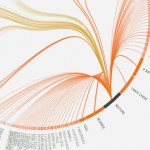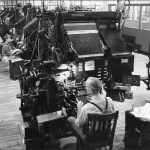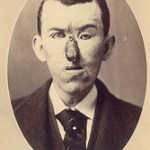history of science
A model of the skull of Megaladapis From A Guide to the Fossil Mammals and Birds in the Department of Geology and Palaeontology in the British Museum (Natural History).
At a meeting of the Royal Society in 1893 the English geologist Henry Woodward read a communication from his Swiss colleague Charles Immanuel Forsyth Major on a new, recently extinct genus of giant lemur from Madagascar. He called it Megaladapis, and it was a lemur with a skull as large a modern gorilla's. Particularly interesting were the thick rims of bone around its eyes which appeared to be oriented slightly upwards.…
A cast of the lower jaw of Dryopithecus available through Ward's Natural Science Establishment.
For most of anthropology's history tools had been thought to be the exclusive hallmark of humanity. That only our species could use and manufacture tools was a sign of our superiority, be it the result of evolution or divine fiat, at least until it was discovered that apes could make tools, too. Though anecdotal accounts of tool use by primates had existed for centuries it was Jane Goodall's research at Gombe in Tanzania that truly shattered the "Man the Tool-Maker" image. When told of her…
The "reincarnated" Cohoes Mastodon. You can see him today at the Cohoes Public Library. (From Natural History)
For decades we have been hearing of the designs of some ambitious scientists to bring the woolly mammoth back to life. I first heard of such plans in the 1980's when I was a young child but they continue to pop up every now and again. Perhaps we could make a mammoth-like creature through the selective breeding of living elephants or a little developmental engineering, but I doubt that a true Mammuthus primigenius will ever exist again. They are long gone.
It may be that what makes…
SEEDmagazine.com interviews Carl Bergstrom, whose eigenfactor project uses citation databases to map networks of information sharing within science:
We find papers to read by following citation trails. If you have an eigenfactor of 1.5, it means 1.5% of the time, a researcher following citation trails is actually trying to get an article from your journal. . . How do you make the right connections, right? How do you make the critical connections to move thought forward? If you can solve a problem like that, or even just make a little contribution to it, it really accelerates science in a…
Maria Mitchell and the Sexing of Science: An Astronomer among the American Romantics
by Renée Bergland
Boston: Beacon Press
2008
What is it like to be a woman scientist? In a society where being a woman is somehow a distinct experience from being an ordinary human being, the answer to this question can be complicated. And, in a time and place where being a scientist, being a professional -- indeed, even being American -- was still being worked out, the complexities of the answer can add up to a biography of that time, that place, that swirl of intellectual and cultural ferment, as well as…
Today is Ada Lovelace Day.
Regular readers of this blog may recall that I am a tremendous Luddite. Obviously, this should not be taken to mean I am against all technological advances across the board (as here I am, typing on a computer, preparing a post that will be published using blogging software on the internet). Rather, I am suspicious of technological advances that seem to arise without much thought about how they influence the experience of the humans interacting with them, and of "improvements" that would require me to sink a bunch of time into learning new commands or operating…
The Sleeping Venus (1944)
Paul Delvaux
Observatory is a new collaborative art space located in Brooklyn, where it is reportedly sandwiched between Proteus Gowanus, Cabinet Magazine, and the Morbid Anatomy library. Its illustrious proprietors include Pam of Phantasmaphile, Joanna of Morbid Anatomy, and D&M of Curious Expeditions. And if that's not reason enough to be excited, tonight they are hosting a talk by Kathryn Hoffmann of the University of Hawaii at Manoa, entitled "Reveries of Sleeping Beauty: Slumber and Death in Anatomical Museums, Fairground Shows, and Art."
I saw Dr. Hoffmann…
Linotype operators work in the composing room at the P-I building at 6th and Wall Street in December, 1948. (Seattle Post-Intelligencer photo)
To follow up on my post about science journalism and blogs, a few reading links dealing with science in society, journalism, and the transformation of media.
First, Peter Dizikes revisits C.P. Snow's ubiquitous "two cultures", fifty years later:
"The Two Cultures" actually embodies one of the deepest tensions in our ideas about progress. Snow, too, wants to believe the sheer force of science cannot be restrained, that it will change the world -- for…
Via Bora's blog, a delightfully cheesy1955 filmstrip about why science education is more important than anything else - even fishing. It starts out slow, but this Sputnik-era treasure turns into a veritable propagandafest about how science literacy is a civic duty. Plus, it raises vital questions like "Why do these kids have weird pseudo-Southern accents even though their parents don't?" and "How can science help Betty 'hook some guy'?"
Remember, women need to know as much about science as some men do! Are you going to be ready?
(Look how bored Betty looks by the end.)
Provenance:…
Can't blog ... lost in AMAZING ARCHIVE OF MEDICAL IMAGES! Today from BoingBoing:
This previously unreported archive at the National Museum of Health and
Medicine in Washington, D.C., contains 500,000 scans of unique images
so far, with another 225,000 set to be digitized this year. Mike Rhode, the museum's head archivist, is working to make tens of
thousands of those images, which have been buried in the museum's
archive, available on Flickr. Working after hours, his team has posted
a curated selection of almost 800 photos on the service already,
without the express permission…
A very unusual reconstruction of Dimetrodon from the textbook Geology, based on a reconstruction by E.C. Case. Dimetrodon and other sail-backed creatures were once considered to have become too "spiny" to survive.
According to the old, if inaccurate, aphorism ontogeny recapitulates phylogeny, or the development of an individual organism replays its evolutionary history. This idea was seen in the work of various scholars, from Ernst Haeckel to Sigmund Freud, but at the turn of the 20th century some paleontologists thought it could hold true stated the other way. Might the evolution of a…
Thanks to reader Paul for this tip - what an amazing piece of history: an instructional movie from the Sputnik Era, explaining why one should study science. Many of the arguments have not changed since then, though the details of sciences and technologies used in the film are very different. The role of women is, well, so 1950s....
Found on Prelinger Archives (more information in the comments) and A/V Geeks:
Family on last night of vacation speaks of stars & then of how study of science can help son & daughter make intelligent decisions on problems confronting them in world.…
A mount of Dimetrodon at the AMNH. From the Bulletin of the AMNH.
The predatory pelycosaur Dimetrodon has always been a favorite of mine. Though not a dinosaur it has an appearance as bizarre as any dinosaur you care to name, and the function of the huge sail on its back is remains an enigma. What could such an impressive structure be used for?
Slight differences in the bony back struts of a similar animal that inhabited the same habitat as Dimetrodon provided paleontologist E.D. Cope with a clue. Where Dimetrodon was a large apex predator "Naosaurus" appeared to be a more peaceful…
A visual summary of horse evolution published in 1921 (derived from an earlier diagram by W.D. Matthew). From An Introduction to the Study of Fossils.
When Charles Darwin published On the Origin of Species by Means of Natural Selection in 1859 he faced a substantial problem. His evolutionary mechanism predicted that the fossil record would contain finely-graded transitions revealing what G.G. Simpson would later term the "tempo and mode" of evolution, yet such transitional creatures proved elusive. This was a major problem for paleontologists who believed that studies of European geology…
From SCONC:
Tuesday, March 31
6:30 p.m.
"Life after Darwin: Are there still big discoveries to be made in biology?" NC State ecologist Rob Dunn continues the NC Museum of Natural Science's Charles Darwin Lecture Series. Free lecture; doors open at 6. Museum of Natural Science, downtown Raleigh. Please RSVP to museum.reservations@ncmail.net.
(Next in the series: Anne Yoder, director of the Duke Lemur Center, and paleontologist Paul Brinkman on Darwin's use of fossil evidence.)
Archy continues to post snippets of his research on the history of the discoveries and descriptions of mammoths:
The description of the mammoth as a subterranean animal that dies on exposure to surface air is almost identical to that given by the Chinese writer Tung-fang So in the second century BC....
Ancestors are important. We like to know where we came from and what sort of legacy our forebears left, but it has only been recently that we have been able to trace the concept of "ancestor" through the depths of geological strata. I may not know the detailed history of my family during the last hundred years or so, but I do know that a number of hominins figure into my family tree.
I am not proud or ashamed of this deeper ancestry which I share with every other Homo sapiens on the planet. It is simply historical fact, but I have to wonder what my education would have been like if earlier…
About two weeks ago I went to Politics and Prose for a great talk by the New Yorker's Adam Gopnik, who was in DC promoting his new book, Angels and Ages, a book of essays about Charles Darwin and Abraham Lincoln. The words and actions of these two influential men - some would call them secular saints - still reverberate today. And coincidentally, they were also born just hours apart, on the same day: February 12, 1809.
Gopnik explicitly said that he did not intend to suss out any mystical or astrological significance to the shared birthday: it's a coincidence, and nothing more. But as he…
Everyone is talking about Atlas Shrugged in reference to current economic woes, but to me the arguments of the Faux News crew are more reminiscent of those made by Herbert Spencer and other "social Darwinists" in the latter half of the 19th century. (Check out Banquet at Delmonico's for more);
.cc_box a:hover .cc_home{background:url('http://www.comedycentral.com/comedycentral/video/assets/syndicated-logo-over.png') !important;}.cc_links a{color:#b9b9b9;text-decoration:none;}.cc_show a{color:#707070;text-decoration:none;}.cc_title a{color:#868686;text-decoration:none;}.cc_links a:hover{color…



